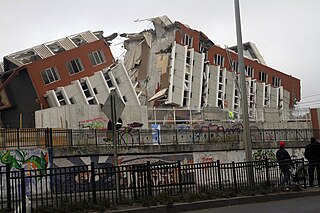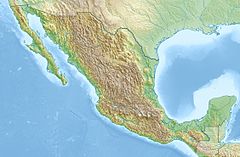
The 2010 Chile earthquake and tsunami occurred off the coast of central Chile on Saturday, 27 February at 03:34 local time, having a magnitude of 8.8 on the moment magnitude scale, with intense shaking lasting for about three minutes. It was felt strongly in six Chilean regions, that together make up about 80 percent of the country's population. According to the United States Geological Survey (USGS) the cities experiencing the strongest shaking—VIII (Severe) on the Mercalli intensity scale (MM)—were Concepción, Arauco, and Coronel. According to Chile's Seismological Service Concepción experienced the strongest shaking at MM IX (Violent). The earthquake was felt in the capital Santiago at MM VII or MM VIII. Tremors were felt in many Argentine cities, including Buenos Aires, Córdoba, Mendoza, and La Rioja. Tremors were felt as far north as the city of Ica in southern Peru.
The 2011 Guerrero earthquake struck with a moment magnitude of 5.7 in southern Mexico at on 5 May. It was positioned west of Ometepec, Guerrero, with a focal depth of 24 km (14.9 mi), and was lightly felt in many adjacent areas.

The 2010 Pichilemu earthquakes, also known as the Libertador O'Higgins earthquakes, were a pair of intraplate earthquakes measuring 6.9 and 7.0 that struck Chile's O'Higgins Region on 11 March 2010 about 16 minutes apart. The earthquakes were centred 15 kilometres (9.3 mi) northwest of the city of Pichilemu.
The 2011 Zumpango earthquake occurred at with a moment magnitude of 6.5 and a maximum Mercalli intensity of VII. Its epicenter was located in the city Zumpango, Guerrero, roughly equidistant between the metropolitan areas of Mexico City and Acapulco. The quake was felt in Guerrero, Michoacán, Mexico State, Mexico City and Puebla.
The 2012 Guerrero–Oaxaca earthquake struck southern Mexico with a moment magnitude of 7.4 at on Tuesday, 20 March. Its epicenter was near Ometepec, in the border between the states of Guerrero and Oaxaca. With a shallow focus of 15 to 20 km, the earthquake caused strong shaking over a large area along the Oaxaca–Guerrero border and the adjacent Pacific coastline. Significant tremors were felt in areas up to several hundred kilometers away, including Mexico City and also in Guatemala. Two people were killed and over 30,000 houses were damaged or destroyed.
The 1787 New Spain earthquake, also known as the San Sixto earthquake, occurred on 28 March at 11:30 local time. It caused a large tsunami that affected the coast of the Puebla Intendancy and the Oaxaca Intendancy in Southwestern New Spain. With an estimated magnitude of 8.6 on the moment magnitude scale, it was more powerful than any instrumentally recorded Mexican earthquake.

The Mexican Seismic Alert System is the earthquake warning system covering portions of central and southern Mexico. It currently provides up to 60 seconds' warning of earthquakes to Mexico City, Acapulco, Chilpancingo, Morelia, Puebla City, Oaxaca City, Guadalajara, Colima and Toluca. SASMEX is administered by a non-profit civil association, Center for Seismic Instrumentation and Registry . The SASMEX sensor network serving Mexico City has been regarded as the first earthquake early warning system issuing alerts available to the public. SASMEX supplies regular information of all kinds, including reports of earthquakes of all magnitudes, and drills, via Twitter, under the name AlertaSísmica SASMEX. All earthquakes are reported as #TenemosSismo ; warnings of serious ones are delivered as #AlertaSismica.

The 2017 Chiapas earthquake struck at 23:49 CDT on 7 September in the Gulf of Tehuantepec off the southern coast of Mexico, near state of Chiapas, approximately 87 kilometres (54 mi) southwest of Pijijiapan, with a Mercalli intensity of IX (Violent). The moment magnitude was estimated to be 8.2, with it receiving 8.4 on the Richter Scale.

The 2017 Puebla earthquake struck at 13:14 CDT on 19 September 2017 with an estimated magnitude of 7.1 and strong shaking for about 20 seconds. Its epicenter was about 55 km (34 mi) south of the city of Puebla, Mexico. The earthquake caused damage in the Mexican states of Puebla and Morelos and in the Greater Mexico City area, including the collapse of more than 40 buildings. 370 people were killed by the earthquake and related building collapses, including 228 in Mexico City, and more than 6,000 were injured.

The Valparaíso earthquake of April 2017 was a strong earthquake that shook the cities of Valparaíso and Santiago on Monday, April 24, 2017 at 18:38 local time. Its epicenter was located off the coast of the Valparaíso Region and had a magnitude of 6.9 Mw. On the scale of Mercalli, the earthquake reached an intensity of VII.
The 1957 Guerrero earthquake occurred on 28 July at 08:40 UTC. It had a magnitude of 7.6 and a maximum perceived intensity of VII on the Modified Mercalli intensity scale. Mexico City and Chilpancingo were particularly badly affected. It caused the deaths of between 54 and 160 people. A small tsunami was triggered but caused little damage.
The 1942 Ecuador earthquake or the Guayaquil earthquake occurred on 13 May at 9:06 or 9:13 pm local time with a moment magnitude of Mw 7.9. The temblor struck the coastal (Esmeraldas) region of Manabí Province, Ecuador. It caused damage mainly to cities like Guayaquil, Portoviejo and Guaranda. More than 300 people were killed and the total cost of damage was about US$2.5 million. Ecuador's largest city Guayaquil was the most affected despite the significant distantce from the epicenter. Many reinforced concrete structures in a particular area in the city were completely destroyed, contributing to fatalities.
The 1900 Venezuelan earthquake, better known as the 1900 San Narciso earthquake, occurred on October 28 at between 4:30 and 4:45 am local time. This earthquake had an epicenter off Miranda State or near the Venezuelan capital Caracas, in the Cariaco Basin. It had an estimated moment magnitude of 7.6–7.7 and a surface wave magnitude of 7.7–8.4. It had a maximum Mercalli intensity assigned VIII–X, causing landslides and liquefaction events. Many buildings were severely damaged or collapsed during the earthquake. It is thought to be the last great earthquake of the 19th century and the largest instrumentally recorded in the republic, having been felt throughout.
The 1979 Petatlán earthquake, also known as the IBERO earthquake occurred on March 14 at 05:07 local time in the Mexican state of Guerrero. The earthquake had a surface wave magnitude of Ms 7.6 or moment magnitude of Mw 7.4 and maximum Modified Mercalli intensity of VIII (Severe). The epicenter, onshore, was located 12 km south southeast of Vallecitos de Zaragoza.
A moment magnitude Mw 7.0 or 7.1 earthquake occurred near the city of Acapulco in the Guerrero state of Mexico at on 7 September with an estimated intensity of VIII (Severe) on the MMI scale. The earthquake killed 13 people and injured at least 23 others. At least 1.6 million people in Mexico were affected by the earthquake which resulted in localized severe damage. The earthquake occurred on the anniversary of the 2017 Chiapas earthquake which measured Mw 8.2. It was also the largest earthquake in Mexico since the 2020 Oaxaca earthquake.

An earthquake struck the Department of Lima, Peru on May 12, 2022. The earthquake caused minor damage and some casualties in the Lima area. Several homes collapsed due to the earthquake.







